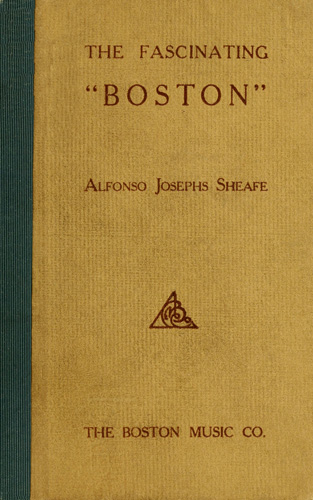
Project Gutenberg's The Fascinating Boston, by Alfonso Josephs Sheafe
This eBook is for the use of anyone anywhere at no cost and with
almost no restrictions whatsoever. You may copy it, give it away or
re-use it under the terms of the Project Gutenberg License included
with this eBook or online at www.gutenberg.org
Title: The Fascinating Boston
How to Dance and How to Teach the Popular New Social Favorite
Author: Alfonso Josephs Sheafe
Release Date: September 15, 2011 [EBook #37443]
Language: English
Character set encoding: ISO-8859-1
*** START OF THIS PROJECT GUTENBERG EBOOK THE FASCINATING BOSTON ***
Produced by David E. Brown and The Online Distributed
Proofreading Team at https://www.pgdp.net (This file was
produced from images generously made available by the
Library of Congress)

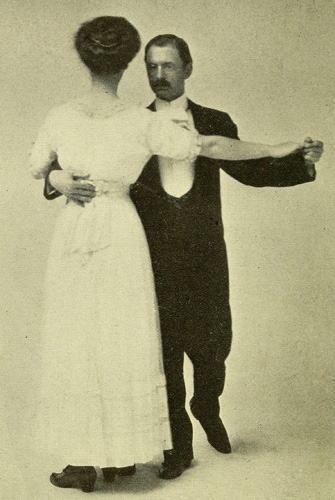
THE FASCINATING
BOSTON
How to Dance and How to Teach the
Popular New Social Favorite
By
ALFONSO JOSEPHS SHEAFE
Master of Dancing
Translator and Editor of
Zorn's Grammar of the Art of Dancing

Boston, Mass.
THE BOSTON MUSIC COMPANY
New York: G. Schirmer, Incorporated
Copyright, 1913, by
THE BOSTON MUSIC CO.
For all countries
B. M. Co. 3366
Table of Contents
| Page | |
| FOREWORD | 1 |
| THE BOSTON | |
| The Fundamental Positions | 5 |
| The Position of the Partners | 8 |
| The Step of the Boston | 12 |
| The Long Boston | 22 |
| The Short Boston | 23 |
| The Open Boston | 24 |
| The Boston Dip | 25 |
| THE TURKEY TROT | 27 |
| THE AEROPLANE GLIDE | 28 |
| THE TANGO | 29 |
THE FASCINATING[1]
BOSTON
FOREWORD
SINCE the introduction of the waltz, more than a hundred years ago, it has held the first place in the esteem of dancers throughout the civilized world. There has appeared, however, a new claimant for the place—one that possesses all the qualities that go to make a social favorite, and has the additional advantages of greater ease of execution, and wider possibilities of adaptation.
This is the BOSTON—not, as many persons suppose, a new creation nor indeed is it a novelty even to the American public, for it was introduced here more than a generation ago; but the great popularity of the Two-Step, which had just then come into vogue, and was fast gaining [2]favor under the influence of such brilliant compositions as the quick-step marches by Sousa, operated against its immediate acceptance.
One of the reasons why the Boston should prove today a more attractive dance than any other, is the fact that now there are more captivating airs written for this particular form of dance than for any other, and as the Two-Step, in its time, found its most powerful ally in the music to which it was adapted, the Boston has today the persuasive intercession of such languorous and haunting melodies as "Love's Awakening" and "On the Wings of Dream," by Danglas; Sinibaldi's "Thrill," and others.
General taste has gradually found out the superior charm of the Boston; the pendulum of public favor has again swung in the direction of skilful dancing.
The recent revival of the Waltz in its proper form, has brought with it a larger appreciation of the more worthy[3] and graceful social dances, and the entire world now recognizes the wonderful beauty of the Boston, and has welcomed it as a real competitor.
The Boston is not a Waltz, yet it is the perfection of it. It is one of those paradoxical things which, while it is impossible to be classified, contains all that is to be found in almost any other dance. Even the persons who have so long and so loyally clung to other forms of dancing, and have abated none in their zeal for their favorites, have been unconsciously, and perhaps unwillingly, charmed by the seductiveness of the Boston, until they now freely declare the new dance to be the superior of the Waltz. Therefore it is safe to say that the Boston will, eventually, supersede the Waltz altogether.
We demand a dance which combines ease of execution with attractive movement. That is just what the Boston does, and perhaps more. It is so simple[4] in construction that, when acquired, it becomes natural, and its perfect adaptability assures it lasting popularity.
Owing to the urgent request of many of his pupils and colleagues, the author has undertaken this little book in the hope that it will meet the requirements of both teachers and students, and help to assure the proper appreciation of what is in reality the most delightful and artistic social dance since the Minuet.
THE FIVE FUNDAMENTAL POSITIONS[5]
In order that the reader may the more readily understand the descriptions given in this book, we will explain the five fundamental positions upon which the art of dancing rests.
In the 1st position, the feet are together, heel against heel.
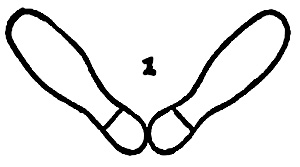
In the 2nd position, the heels are separated sidewise, and on the same line.
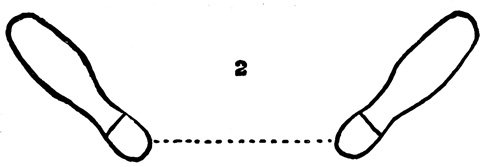
[6]In the 3rd position, the heel of one foot touches the middle of the other.
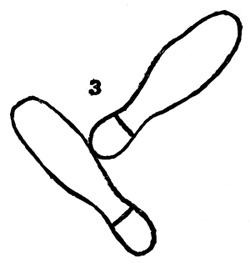
In the 4th position, the feet are separated as in walking, either directly forward or directly backward.

[7]In the 5th position, the heel of one foot touches the point of the other.
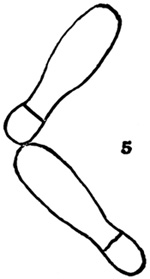
In all these positions the feet must be turned outward to form not less than a right angle.
THE POSITIONS OF THE PARTNERS[8]
Much, if not all, of the adverse criticism of the Boston which has been offered by educators, parents and other responsible objectors, has been directed at the relative positions of the partners. This is, in fact, no more than the general rule as regards the Social Round Dance, with the possible exception that the positions have been sometimes distorted by attempts to copy the freer forms of dancing that have been presented upon the stage.
The Round Dance demands that a certain fixed grouping of the partners be maintained in order that the rotation around a common moving centre may be accomplished, and it is here that the most serious problem is to be found.
The dancing profession long ago undertook to settle upon arbitrary groupings[9] satisfactory to the needs of the dancers, and conforming to all the requirements of propriety and hygienic exercise.
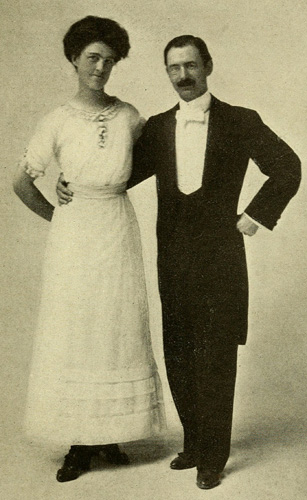
Acting upon this basis, the reputable teachers of dancing throughout the world have adopted and promulgated three fundamental groupings for the Round Dance which are so constructed as to provide the greatest ease of execution and freedom of action. They are known as the Waltz Position, the Open Position, and the Side Position of the Waltz. All round dances are executed in one or another of these groupings, which are not only accepted by all good teachers, but, with the exception of certain minor and unimportant variations, rigidly adhered to in all their work.
In the Waltz Position the partners stand facing one another, with shoulders parallel, and looking over one another's right shoulder. Special attention[10] must be paid to the parallel position of the shoulders, in order to fit the individual movements of the partners along the line of direction.
The gentleman places his right hand lightly upon the lady's back, at a point about half-way across, between the waist-line and the shoulder-blades. The fingers are so rounded as to permit the free circulation of air between the palm of the hand and the lady's back, and should not be spread.
The lady places her left hand lightly upon the gentleman's arm, allowing her fore-arm to rest gently upon his arm. The partners stand at an easy distance from one another, inclining toward the common centre very slightly. The free hands are lightly joined at the side. This is merely to provide occupation for the disengaged arms, and the gentleman holds the tip of the lady's hand lightly in the bended fingers of his own. Guiding is accomplished by the gentleman through a slight lifting of his right elbow.
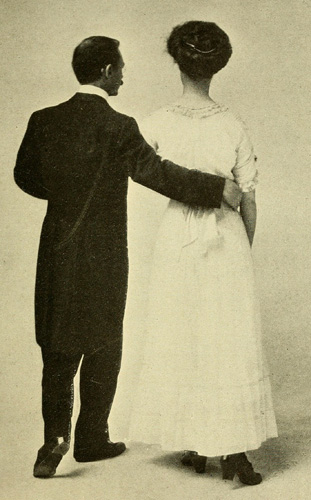
THE OPEN POSITION[11]
The Open Position needs no explanation, and can be readily understood from the illustration facing page 8.
THE SIDE POSITION OF THE WALTZ
The side position of the Waltz differs from the Waltz Position only in the fact that the partners stand side by side and with the engaged arms more widely extended. The free arms are held as in the frontispiece. In the actual rotation this position naturally resolves itself into the regular Waltz Position.[12]
THE STEP OF THE BOSTON
The preparatory step of the Boston differs materially from that of any other Social Dance. There is only one position of the feet in the Boston—the 4th. That is to say, the feet are separated one from the other as in walking.
On the first count of the measure the whole leg swings freely, and as a unit, from the hip, and the foot is put down practically flat upon the floor, where it immediately receives the entire weight of the body perpendicularly. The weight is held entirely upon this foot during the remainder of the measure, whether it be in 3/4 or 2/4 time.
The following preparatory exercises must be practiced forward and backward until the movements become natural, before proceeding.
[13]In going backward, the foot must be carried to the rear as far as possible, and the weight must always be perpendicular to the supporting foot.
These movements are identical with walking, and except the particular care which must be bestowed upon the placing of the foot on the first count of the measure, they require no special degree of attention.
On the second count the free leg swings forward until the knee has become entirely straightened, and is held, suspended, during the third count of the measure. This should be practiced, first with the weight resting upon the entire sole of the supporting foot, and then, when this has been perfectly accomplished, the same exercise may be supplemented by raising the heel (of the supporting foot) on the second count and lowering it on the third count. Great care must be taken not to divide the weight.
[14]For the purpose of instruction, it is well to practice these steps to Mazurka music, because of the clearness of the count.
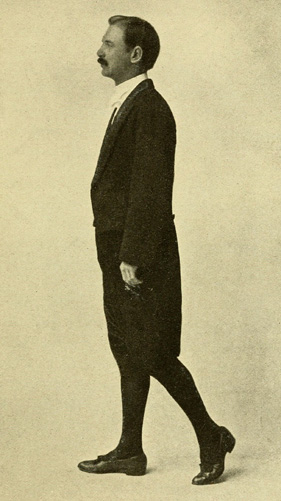
When the foregoing exercises have been so fully mastered as to become, in a sense, muscular habits, we may, with safety, add the next feature. This consists in touching the floor with the point of the free foot, at a point as far forward or backward as can be done without dividing the weight, on the second count of the measure. Thus, we have accomplished, as it were, an interrupted, or, at least, an arrested step, and this is the true essence of the Boston.
Too great care cannot be expended upon this phase of the step, and it must be practiced over and over again, both forward and backward, until the movement has become second nature. All this must precede any attempt to turn.
The turning of the Boston is simplicity itself, but it is, nevertheless, the one[15] point in the instruction which is most bothersome to learners. The turn is executed upon the ball of the supporting foot, and consists in twisting half round without lifting either foot from the ground. In this, the weight is held altogether upon the supporting foot, and there is no crossing.
In carrying the foot forward for the second movement, the knees must pass close to one another, and care must be taken that the entire half turn comes upon the last count of the measure.
To sum up:—
Starting with the weight upon the left foot, step forward, placing the entire weight upon the right foot, as in the illustration facing page 14 (count 1); swing left leg quickly forward, straightening the left knee and raising the right heel, and touch the floor with the extended left foot as in the illustration facing page 16, but without placing any weight upon that foot (count 2); execute[16] a half-turn to the left, backward, upon the ball of the supporting (right) foot, at the same time lowering the right heel, and finish as in the illustration opposite page 18 (count 3). One measure.
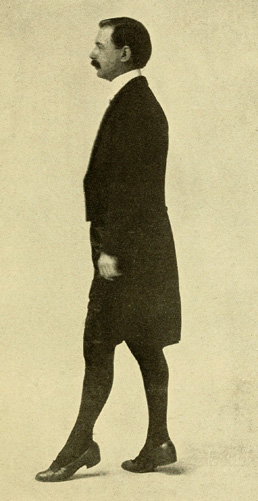
Starting again, this time with the weight wholly upon the right foot, and with the left leg extended backward, and the point of the left foot lightly touching the floor, step backward, throwing the weight entirely upon the left foot which sinks to a position flat upon the floor, as shown in the illustration facing page 21, (count 4); carry the right foot quickly backward, and touch with the point as far back as possible upon the line of direction without dividing the weight, at the same time raising the left heel as in the illustration facing page 22, (count 5); and complete the rotation by executing a half-turn to the right, forward, upon the ball of the left foot, simultaneously lowering the left heel, and finishing as in the illustration facing page 24, (count 6).
THE REVERSE[17]
The reverse of the step should be acquired at the same time as the rotation to the right, and it is, therefore, of great importance to alternate from the right to the left rotation from the beginning of the turning exercise. The reverse itself, that is to say, the act of alternating is effected in a single measure without turning (see preparatory exercise, page 13) which may be taken backward by the gentleman and forward by the lady, whenever they have completed a whole turn.
The mechanism of the reverse turn is exactly the same as that of the turn to the right, except that it is accomplished with the other foot, and in the opposite direction.
There is no better or more efficacious exercise to perfect the Boston, than that which is made up of one complete turn[18] to the right, a measure to reverse, and a complete turn to the left. This should be practised until one has entirely mastered the motion and rhythm of the dance. The writer has used this exercise in all his work, and finds it not only helpful and interesting to the pupil, but of special advantage in obviating the possibility of dizziness, and the consequent unpleasantness and loss of time.
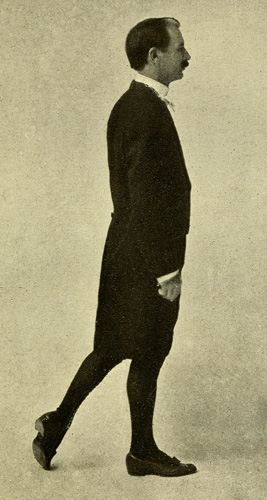
After acquiring a degree of ease in the execution of these movements to Mazurka music, it is advisable to vary the rhythm by the introduction of Spanish or other clearly accented Waltz music, before using the more liquid compositions of Strauss or such modern song waltzes as those of Danglas, Sinibaldi, etc.
It is one of the remarkable features of the Boston that the weight is always opposite the line of direction—that is to say, in going forward, the weight is retained upon the rear foot, and in going[19] backward, the weight is always upon the front foot (direction always radiates from the dancer). Thus, in proceeding around the room, the weight must always be held back, instead of inclining slightly forward as in the other round dances. This seeming contradiction of forces lends to the Boston a unique charm which is to be found in no other dance.
As the dancer becomes more familiar with the Boston, the movement becomes so natural that little or no thought need be paid to technique, in order to develop the peculiar grace of it.
The fact of its being a dance altogether in one position calls for greater skill in the execution of the Boston, than would be the case if there were other changes and contrasts possible, just as it is more difficult to play a melody upon a violin of only one string.
The Boston, in its completed form, resolves itself into a sort of walking[20] movement, so natural and easy that it may be enjoyed for a whole evening without more fatigue than would be the result of a single hour of the Waltz and Two-Step.
Aside from the attractiveness of the Boston as a social dance, its physical benefits are more positive than those of any other Round Dance that we have ever had. The action is so adjusted as to provide the maximum of muscular exercise and the minimum of physical effort. This tends towards the conservation of energy, and produces and maintains, at the same time an evenness of blood pressure and circulation. The movements also necessitate a constant exercise of the ankles and insteps which is very strengthening to those parts, and cannot fail to raise and support the arch of the foot.
Taken from any standpoint, the Boston is one of the most worthy forms of the social dance ever devised, and the[21] distortions of position which are now occasionally practiced must soon give way to the genuinely refining influence of the action.
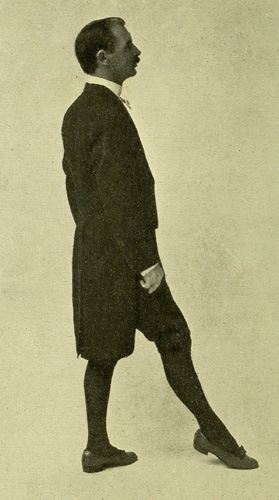
Of the various forms of the Boston, there is little to be said beyond the description of the manner of their execution, which will be treated in the following pages.
It is hoped that this book will help toward a more complete understanding of the beauties and attractions of the Boston, and further the proper appreciation of it.[22]
All descriptions of dances given in this book relate to the lady's part. The gentleman's is exactly the same, but in the countermotion.
THE LONG BOSTON
The ordinary form of the Boston as described in the foregoing pages is commonly known as the "Long" Boston to distinguish it from other forms and variations. It is danced in 3/4 time, either Waltz or Mazurka, and at any tempo desired. As this is the fundamental form of the Boston, it should be thoroughly acquired before undertaking any other.
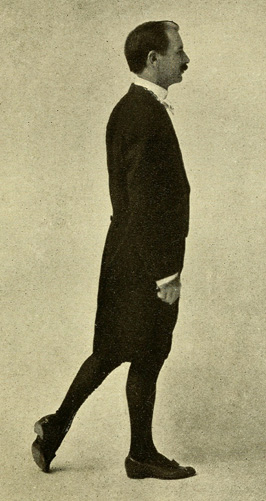
THE SHORT BOSTON[23]
The "Short" Boston differs from the "Long" Boston only in measure. It is danced in either 2/4 or 6/8 time, and the first movement (in 2/4 time) occupies the duration of a quarter-note. The second and third movements each occupy the duration of an eighth-note. Thus, there exists between the "Long" and the "Short" Boston the same difference as between the Waltz and the Galop. In the more rapid forms of the "Short" Boston, the rising and sinking upon the second and third movements naturally take the form of a hop or skip. The dance is more enjoyable and less fatiguing in moderate tempo.
THE OPEN BOSTON[24]
The "Open" Boston contains two parts of eight measures each. The first part is danced in the positions shown in the illustrations facing pages 8 and 10, and the second part consists of 8 measures of the "Long" Boston.
In the first part, the dancers execute three Boston steps forward, without turning, and one Boston step turning (towards the partner) to face directly backward (1/2 turn). 4 measures.
This is followed by three Boston steps backward (without turning) in the position shown in the illustration facing page 10, followed by one Boston step turning (toward the partner) and finishing in regular Waltz Position for the execution of the second part.
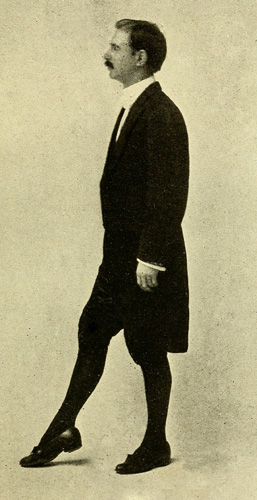
THE BOSTON DIP[25]
The "Dip" is a combination dance in 3/4 or 3/8 time, and contains 4 measures of the "Long" Boston, preceded by 4 measures, as follows:
Standing upon the left foot, step directly to the side, and transfer the weight to the right foot (count 1); swing the left leg to the right in front of the right, at the same time raising the right heel (count 2); lower the right heel (count 3); return the left foot to its original place where it receives the weight (count 4); swing the right leg across in front of the left, raising the left heel (count 5); and lower the left heel (count 6). 2 measures.
[26]Swing the right foot to the right, and put it down directly at the side of the left (count 1); hop on the right foot and swing the left across in front (count 2); fall back upon the right foot (count 3); put down the left foot, crossing in front of the right, and transfer weight to it (count 4); with right foot step a whole step to the right (count 5); and finish by bringing the left foot against the right, where it receives the weight (count 6). 2 measures.
In executing the hop upon counts 2 and 3 of the third measure, the movement must be so far delayed that the falling back will exactly coincide with the third count of the music.
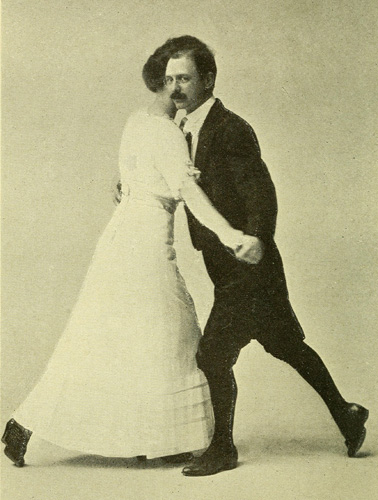
THE TURKEY TROT
Preparation:—Side Position of the Waltz.
During the first four measures take four Boston steps without turning (lady forward, gentleman backward), and bending the supporting knee, stretch the free foot backward, (lady's left, gentleman's right) as shown in the illustration opposite. 4 meas.
Repeat in opposite direction. 4 meas.
Execute four drawing steps to the side (lady's right, gentleman's left) swaying the shoulders and body in the direction of the drawn foot, and pointing with the free foot upon the fourth, as shown in figure. 4 meas.
Repeat in opposite direction. 4 meas.
Eight whole turns, Short Boston or Two-Step. 16 meas.
Repeat at will.
A splendid specimen for this dance will be found in "The Gobbler" by J. Monroe.
THE AEROPLANE GLIDE
The "Aeroplane Glide" is very similar to the Boston Dip. It is supposed to represent the start of the flight of an aeroplane, and derives its name from that fact.
The sole difference between the "Dip" and "Aeroplane" consists in the six running steps which make up the first two measures. Of these running steps, which are executed sidewise and with alternate crossings, before and behind, only the fourth, at the beginning of the second measure requires special description. Upon this step, the supporting knee is noticeably bended to coincide with the accent of the music.
The rest of the dance is identical with the "Dip". (See page 25.)

THE TANGO
The Tango is a Spanish American dance which contains much of the peculiar charm of the other Spanish dances, and its execution depends largely upon the ability of the dancers so to grasp the rhythm of the music as to interpret it by their movements. The steps are all simple, and the dancers are permitted to vary or improvise the figures at will.
Of these figures the two which follow are most common, and lend themselves most readily to verbal description.
TANGO No. 1[30]
The partners face one another as in Waltz Position. The gentleman takes the lady's right hand in his left, and, stretching the arms to the full extent, holding them at the shoulder height, he places her right hand upon his left shoulder, and holds it there, as in the illustration opposite page 30.
In starting, the gentleman throws his right shoulder slightly back and steps directly backward with his left foot, while the lady follows forward with her right. In this manner both continue two steps, crossing one foot over the other and then execute a half-turn in the same direction. This is followed by four measures of the Two-Step and the whole is repeated at will. 8 measures.
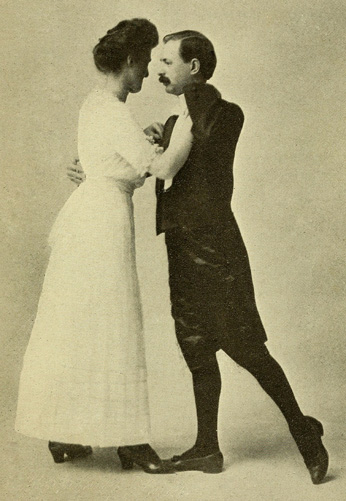
TANGO No. 2[31]
This variant starts from the same position as Tango No. 1. The gentleman takes two steps backward with the lady following forward, and then two steps to the side (the lady's right and the gentleman's left) and two steps in the opposite direction to the original position. 8 measures.
These steps to the side should be marked by the swaying of the bodies as the feet are drawn together on the second count of the measure, and the whole is followed by 8 measures of the Two-Step. Repeat all as desired.
Ideal Music for the "Boston"
PIANO SOLO
(Also to be had for Full or Small Orchestra)
| LOVE'S AWAKENING | J. Danglas | .60 |
| ON THE WINGS OF DREAM | J. Danglas | .60 |
| FRISSON (Thrill!) | S. Sinibaldi | .50 |
| LOVE'S TRIUMPH | A. Daniele | .60 |
| DOUCEMENT | G. Robert | .60 |
| VIENNOISE | A. Duval | .60 |
These selected numbers have attained success, not alone for their attractions of melody and rich harmony, but for their rhythmical flexibility and perfect adaptedness to the "Boston."
For the Turkey Trot
Especially recommended
| THE GOBBLER | J. Monroe | .50 |
Any of the foregoing compositions will be supplied on receipt of one-half the list price. Postage two cents extra for each copy.
PUBLISHED BY
THE BOSTON MUSIC COMPANY
26 & 28 West St., Boston, Mass.
TRANSCRIBER'S NOTES:
Punctuation has been corrected without note.
Obvious typographical errors have been corrected as follows:
Page 8: duplicate word the removed.
Page 23: duplicate word and removed.
End of Project Gutenberg's The Fascinating Boston, by Alfonso Josephs Sheafe
*** END OF THIS PROJECT GUTENBERG EBOOK THE FASCINATING BOSTON ***
***** This file should be named 37443-h.htm or 37443-h.zip *****
This and all associated files of various formats will be found in:
https://www.gutenberg.org/3/7/4/4/37443/
Produced by David E. Brown and The Online Distributed
Proofreading Team at https://www.pgdp.net (This file was
produced from images generously made available by the
Library of Congress)
Updated editions will replace the previous one--the old editions
will be renamed.
Creating the works from public domain print editions means that no
one owns a United States copyright in these works, so the Foundation
(and you!) can copy and distribute it in the United States without
permission and without paying copyright royalties. Special rules,
set forth in the General Terms of Use part of this license, apply to
copying and distributing Project Gutenberg-tm electronic works to
protect the PROJECT GUTENBERG-tm concept and trademark. Project
Gutenberg is a registered trademark, and may not be used if you
charge for the eBooks, unless you receive specific permission. If you
do not charge anything for copies of this eBook, complying with the
rules is very easy. You may use this eBook for nearly any purpose
such as creation of derivative works, reports, performances and
research. They may be modified and printed and given away--you may do
practically ANYTHING with public domain eBooks. Redistribution is
subject to the trademark license, especially commercial
redistribution.
*** START: FULL LICENSE ***
THE FULL PROJECT GUTENBERG LICENSE
PLEASE READ THIS BEFORE YOU DISTRIBUTE OR USE THIS WORK
To protect the Project Gutenberg-tm mission of promoting the free
distribution of electronic works, by using or distributing this work
(or any other work associated in any way with the phrase "Project
Gutenberg"), you agree to comply with all the terms of the Full Project
Gutenberg-tm License (available with this file or online at
https://gutenberg.org/license).
Section 1. General Terms of Use and Redistributing Project Gutenberg-tm
electronic works
1.A. By reading or using any part of this Project Gutenberg-tm
electronic work, you indicate that you have read, understand, agree to
and accept all the terms of this license and intellectual property
(trademark/copyright) agreement. If you do not agree to abide by all
the terms of this agreement, you must cease using and return or destroy
all copies of Project Gutenberg-tm electronic works in your possession.
If you paid a fee for obtaining a copy of or access to a Project
Gutenberg-tm electronic work and you do not agree to be bound by the
terms of this agreement, you may obtain a refund from the person or
entity to whom you paid the fee as set forth in paragraph 1.E.8.
1.B. "Project Gutenberg" is a registered trademark. It may only be
used on or associated in any way with an electronic work by people who
agree to be bound by the terms of this agreement. There are a few
things that you can do with most Project Gutenberg-tm electronic works
even without complying with the full terms of this agreement. See
paragraph 1.C below. There are a lot of things you can do with Project
Gutenberg-tm electronic works if you follow the terms of this agreement
and help preserve free future access to Project Gutenberg-tm electronic
works. See paragraph 1.E below.
1.C. The Project Gutenberg Literary Archive Foundation ("the Foundation"
or PGLAF), owns a compilation copyright in the collection of Project
Gutenberg-tm electronic works. Nearly all the individual works in the
collection are in the public domain in the United States. If an
individual work is in the public domain in the United States and you are
located in the United States, we do not claim a right to prevent you from
copying, distributing, performing, displaying or creating derivative
works based on the work as long as all references to Project Gutenberg
are removed. Of course, we hope that you will support the Project
Gutenberg-tm mission of promoting free access to electronic works by
freely sharing Project Gutenberg-tm works in compliance with the terms of
this agreement for keeping the Project Gutenberg-tm name associated with
the work. You can easily comply with the terms of this agreement by
keeping this work in the same format with its attached full Project
Gutenberg-tm License when you share it without charge with others.
1.D. The copyright laws of the place where you are located also govern
what you can do with this work. Copyright laws in most countries are in
a constant state of change. If you are outside the United States, check
the laws of your country in addition to the terms of this agreement
before downloading, copying, displaying, performing, distributing or
creating derivative works based on this work or any other Project
Gutenberg-tm work. The Foundation makes no representations concerning
the copyright status of any work in any country outside the United
States.
1.E. Unless you have removed all references to Project Gutenberg:
1.E.1. The following sentence, with active links to, or other immediate
access to, the full Project Gutenberg-tm License must appear prominently
whenever any copy of a Project Gutenberg-tm work (any work on which the
phrase "Project Gutenberg" appears, or with which the phrase "Project
Gutenberg" is associated) is accessed, displayed, performed, viewed,
copied or distributed:
This eBook is for the use of anyone anywhere at no cost and with
almost no restrictions whatsoever. You may copy it, give it away or
re-use it under the terms of the Project Gutenberg License included
with this eBook or online at www.gutenberg.org
1.E.2. If an individual Project Gutenberg-tm electronic work is derived
from the public domain (does not contain a notice indicating that it is
posted with permission of the copyright holder), the work can be copied
and distributed to anyone in the United States without paying any fees
or charges. If you are redistributing or providing access to a work
with the phrase "Project Gutenberg" associated with or appearing on the
work, you must comply either with the requirements of paragraphs 1.E.1
through 1.E.7 or obtain permission for the use of the work and the
Project Gutenberg-tm trademark as set forth in paragraphs 1.E.8 or
1.E.9.
1.E.3. If an individual Project Gutenberg-tm electronic work is posted
with the permission of the copyright holder, your use and distribution
must comply with both paragraphs 1.E.1 through 1.E.7 and any additional
terms imposed by the copyright holder. Additional terms will be linked
to the Project Gutenberg-tm License for all works posted with the
permission of the copyright holder found at the beginning of this work.
1.E.4. Do not unlink or detach or remove the full Project Gutenberg-tm
License terms from this work, or any files containing a part of this
work or any other work associated with Project Gutenberg-tm.
1.E.5. Do not copy, display, perform, distribute or redistribute this
electronic work, or any part of this electronic work, without
prominently displaying the sentence set forth in paragraph 1.E.1 with
active links or immediate access to the full terms of the Project
Gutenberg-tm License.
1.E.6. You may convert to and distribute this work in any binary,
compressed, marked up, nonproprietary or proprietary form, including any
word processing or hypertext form. However, if you provide access to or
distribute copies of a Project Gutenberg-tm work in a format other than
"Plain Vanilla ASCII" or other format used in the official version
posted on the official Project Gutenberg-tm web site (www.gutenberg.org),
you must, at no additional cost, fee or expense to the user, provide a
copy, a means of exporting a copy, or a means of obtaining a copy upon
request, of the work in its original "Plain Vanilla ASCII" or other
form. Any alternate format must include the full Project Gutenberg-tm
License as specified in paragraph 1.E.1.
1.E.7. Do not charge a fee for access to, viewing, displaying,
performing, copying or distributing any Project Gutenberg-tm works
unless you comply with paragraph 1.E.8 or 1.E.9.
1.E.8. You may charge a reasonable fee for copies of or providing
access to or distributing Project Gutenberg-tm electronic works provided
that
- You pay a royalty fee of 20% of the gross profits you derive from
the use of Project Gutenberg-tm works calculated using the method
you already use to calculate your applicable taxes. The fee is
owed to the owner of the Project Gutenberg-tm trademark, but he
has agreed to donate royalties under this paragraph to the
Project Gutenberg Literary Archive Foundation. Royalty payments
must be paid within 60 days following each date on which you
prepare (or are legally required to prepare) your periodic tax
returns. Royalty payments should be clearly marked as such and
sent to the Project Gutenberg Literary Archive Foundation at the
address specified in Section 4, "Information about donations to
the Project Gutenberg Literary Archive Foundation."
- You provide a full refund of any money paid by a user who notifies
you in writing (or by e-mail) within 30 days of receipt that s/he
does not agree to the terms of the full Project Gutenberg-tm
License. You must require such a user to return or
destroy all copies of the works possessed in a physical medium
and discontinue all use of and all access to other copies of
Project Gutenberg-tm works.
- You provide, in accordance with paragraph 1.F.3, a full refund of any
money paid for a work or a replacement copy, if a defect in the
electronic work is discovered and reported to you within 90 days
of receipt of the work.
- You comply with all other terms of this agreement for free
distribution of Project Gutenberg-tm works.
1.E.9. If you wish to charge a fee or distribute a Project Gutenberg-tm
electronic work or group of works on different terms than are set
forth in this agreement, you must obtain permission in writing from
both the Project Gutenberg Literary Archive Foundation and Michael
Hart, the owner of the Project Gutenberg-tm trademark. Contact the
Foundation as set forth in Section 3 below.
1.F.
1.F.1. Project Gutenberg volunteers and employees expend considerable
effort to identify, do copyright research on, transcribe and proofread
public domain works in creating the Project Gutenberg-tm
collection. Despite these efforts, Project Gutenberg-tm electronic
works, and the medium on which they may be stored, may contain
"Defects," such as, but not limited to, incomplete, inaccurate or
corrupt data, transcription errors, a copyright or other intellectual
property infringement, a defective or damaged disk or other medium, a
computer virus, or computer codes that damage or cannot be read by
your equipment.
1.F.2. LIMITED WARRANTY, DISCLAIMER OF DAMAGES - Except for the "Right
of Replacement or Refund" described in paragraph 1.F.3, the Project
Gutenberg Literary Archive Foundation, the owner of the Project
Gutenberg-tm trademark, and any other party distributing a Project
Gutenberg-tm electronic work under this agreement, disclaim all
liability to you for damages, costs and expenses, including legal
fees. YOU AGREE THAT YOU HAVE NO REMEDIES FOR NEGLIGENCE, STRICT
LIABILITY, BREACH OF WARRANTY OR BREACH OF CONTRACT EXCEPT THOSE
PROVIDED IN PARAGRAPH 1.F.3. YOU AGREE THAT THE FOUNDATION, THE
TRADEMARK OWNER, AND ANY DISTRIBUTOR UNDER THIS AGREEMENT WILL NOT BE
LIABLE TO YOU FOR ACTUAL, DIRECT, INDIRECT, CONSEQUENTIAL, PUNITIVE OR
INCIDENTAL DAMAGES EVEN IF YOU GIVE NOTICE OF THE POSSIBILITY OF SUCH
DAMAGE.
1.F.3. LIMITED RIGHT OF REPLACEMENT OR REFUND - If you discover a
defect in this electronic work within 90 days of receiving it, you can
receive a refund of the money (if any) you paid for it by sending a
written explanation to the person you received the work from. If you
received the work on a physical medium, you must return the medium with
your written explanation. The person or entity that provided you with
the defective work may elect to provide a replacement copy in lieu of a
refund. If you received the work electronically, the person or entity
providing it to you may choose to give you a second opportunity to
receive the work electronically in lieu of a refund. If the second copy
is also defective, you may demand a refund in writing without further
opportunities to fix the problem.
1.F.4. Except for the limited right of replacement or refund set forth
in paragraph 1.F.3, this work is provided to you 'AS-IS' WITH NO OTHER
WARRANTIES OF ANY KIND, EXPRESS OR IMPLIED, INCLUDING BUT NOT LIMITED TO
WARRANTIES OF MERCHANTIBILITY OR FITNESS FOR ANY PURPOSE.
1.F.5. Some states do not allow disclaimers of certain implied
warranties or the exclusion or limitation of certain types of damages.
If any disclaimer or limitation set forth in this agreement violates the
law of the state applicable to this agreement, the agreement shall be
interpreted to make the maximum disclaimer or limitation permitted by
the applicable state law. The invalidity or unenforceability of any
provision of this agreement shall not void the remaining provisions.
1.F.6. INDEMNITY - You agree to indemnify and hold the Foundation, the
trademark owner, any agent or employee of the Foundation, anyone
providing copies of Project Gutenberg-tm electronic works in accordance
with this agreement, and any volunteers associated with the production,
promotion and distribution of Project Gutenberg-tm electronic works,
harmless from all liability, costs and expenses, including legal fees,
that arise directly or indirectly from any of the following which you do
or cause to occur: (a) distribution of this or any Project Gutenberg-tm
work, (b) alteration, modification, or additions or deletions to any
Project Gutenberg-tm work, and (c) any Defect you cause.
Section 2. Information about the Mission of Project Gutenberg-tm
Project Gutenberg-tm is synonymous with the free distribution of
electronic works in formats readable by the widest variety of computers
including obsolete, old, middle-aged and new computers. It exists
because of the efforts of hundreds of volunteers and donations from
people in all walks of life.
Volunteers and financial support to provide volunteers with the
assistance they need are critical to reaching Project Gutenberg-tm's
goals and ensuring that the Project Gutenberg-tm collection will
remain freely available for generations to come. In 2001, the Project
Gutenberg Literary Archive Foundation was created to provide a secure
and permanent future for Project Gutenberg-tm and future generations.
To learn more about the Project Gutenberg Literary Archive Foundation
and how your efforts and donations can help, see Sections 3 and 4
and the Foundation web page at https://www.pglaf.org.
Section 3. Information about the Project Gutenberg Literary Archive
Foundation
The Project Gutenberg Literary Archive Foundation is a non profit
501(c)(3) educational corporation organized under the laws of the
state of Mississippi and granted tax exempt status by the Internal
Revenue Service. The Foundation's EIN or federal tax identification
number is 64-6221541. Its 501(c)(3) letter is posted at
https://pglaf.org/fundraising. Contributions to the Project Gutenberg
Literary Archive Foundation are tax deductible to the full extent
permitted by U.S. federal laws and your state's laws.
The Foundation's principal office is located at 4557 Melan Dr. S.
Fairbanks, AK, 99712., but its volunteers and employees are scattered
throughout numerous locations. Its business office is located at
809 North 1500 West, Salt Lake City, UT 84116, (801) 596-1887, email
business@pglaf.org. Email contact links and up to date contact
information can be found at the Foundation's web site and official
page at https://pglaf.org
For additional contact information:
Dr. Gregory B. Newby
Chief Executive and Director
gbnewby@pglaf.org
Section 4. Information about Donations to the Project Gutenberg
Literary Archive Foundation
Project Gutenberg-tm depends upon and cannot survive without wide
spread public support and donations to carry out its mission of
increasing the number of public domain and licensed works that can be
freely distributed in machine readable form accessible by the widest
array of equipment including outdated equipment. Many small donations
($1 to $5,000) are particularly important to maintaining tax exempt
status with the IRS.
The Foundation is committed to complying with the laws regulating
charities and charitable donations in all 50 states of the United
States. Compliance requirements are not uniform and it takes a
considerable effort, much paperwork and many fees to meet and keep up
with these requirements. We do not solicit donations in locations
where we have not received written confirmation of compliance. To
SEND DONATIONS or determine the status of compliance for any
particular state visit https://pglaf.org
While we cannot and do not solicit contributions from states where we
have not met the solicitation requirements, we know of no prohibition
against accepting unsolicited donations from donors in such states who
approach us with offers to donate.
International donations are gratefully accepted, but we cannot make
any statements concerning tax treatment of donations received from
outside the United States. U.S. laws alone swamp our small staff.
Please check the Project Gutenberg Web pages for current donation
methods and addresses. Donations are accepted in a number of other
ways including including checks, online payments and credit card
donations. To donate, please visit: https://pglaf.org/donate
Section 5. General Information About Project Gutenberg-tm electronic
works.
Professor Michael S. Hart was the originator of the Project Gutenberg-tm
concept of a library of electronic works that could be freely shared
with anyone. For thirty years, he produced and distributed Project
Gutenberg-tm eBooks with only a loose network of volunteer support.
Project Gutenberg-tm eBooks are often created from several printed
editions, all of which are confirmed as Public Domain in the U.S.
unless a copyright notice is included. Thus, we do not necessarily
keep eBooks in compliance with any particular paper edition.
Most people start at our Web site which has the main PG search facility:
https://www.gutenberg.org
This Web site includes information about Project Gutenberg-tm,
including how to make donations to the Project Gutenberg Literary
Archive Foundation, how to help produce our new eBooks, and how to
subscribe to our email newsletter to hear about new eBooks.